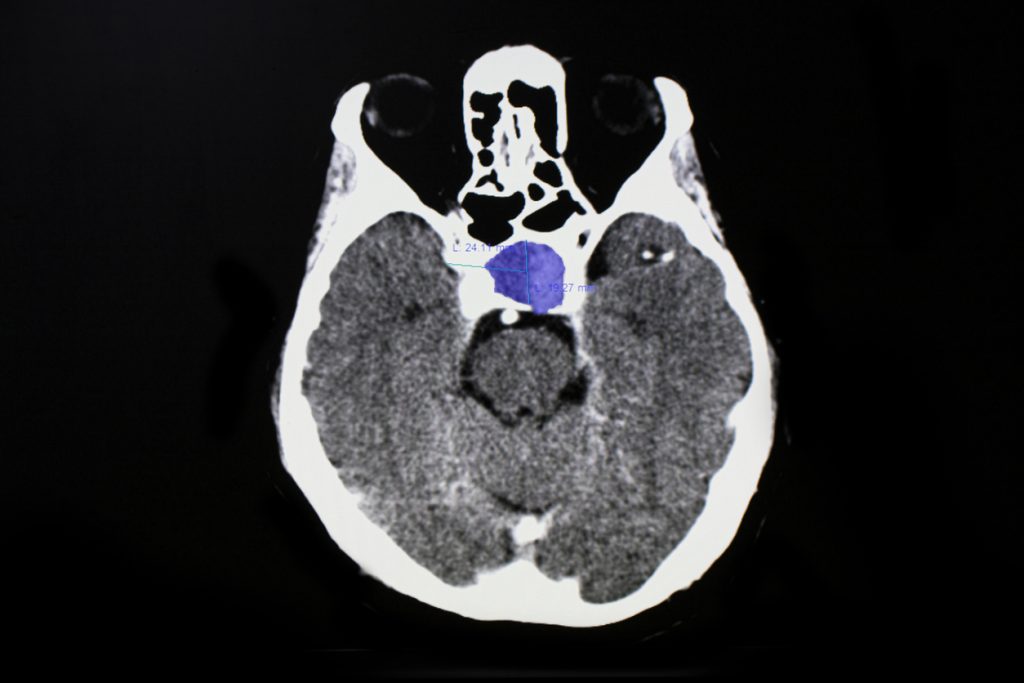Pituitary Tumor Surgery in Staten Island, NY
Pituitary tumors are growths that develop in the pituitary gland, a portion of the brain that is responsible for hormone production. When a patient has a pituitary tumor, they may or may not experience symptoms. But when symptoms do occur, they can be debilitating and severe. Richmond University Medical Center offers a variety of surgical treatments and other methods to reduce symptoms of a pituitary tumor, allowing patients to get back to their everyday lives. Learn more about pituitary tumors and the treatments available at our locations on Staten Island, NY.
What Is a Pituitary Tumor?
A pituitary tumor is an unusual mass or lump that grows in the pituitary gland. The pituitary gland can be found in the brain, above the nose and close to optic nerves. It is a part of the endocrine system, which is the part of the body that regulates hormones and other elements. These elements allow the brain, nervous, and reproductive systems to develop properly as a patient ages. The pituitary gland is made up of two elements – the anterior pituitary and the posterior pituitary. It connects the hypothalamus, which is a part of the brain that releases hormones.
The pituitary gland is specifically responsible for sending essential hormones throughout the body. Because it connects to the hypothalamus, the pituitary gland acts as a bridge to allow hormones to disperse throughout the body. The pituitary gland then begins to create its own hormones as others are being pushed through. These hormones are what keep other hormones controlled within the body. Generally, hormones are the chemicals in the blood that help regulate organ function. When tumors grow in the pituitary gland, this can cause a variety of different hormones to overproduce. In turn, this can cause many physical symptoms to arise, such as:
- Abnormally tall height
- Pain or numbness in the face
- Passing out or dizziness
- Fatigue or weakness
- Breast tissue development in men
- Unintentional weight loss or gain
- Menstrual cycle changes
- Low or high blood pressure
- Losing body hair or increased body hair growth
- Frequent sweating
- Rapid growth in children
- Pain in the joints
- Tingling or numbness in feet or hands
- Changes in facial structure
The location of the tumor can impact which hormones it affects, meaning patients can experience varying symptoms of a pituitary tumor. Those with a pituitary tumor can also experience symptoms like headaches or vision issues. This is because as pituitary tumors grow, they press against optic nerves. Pituitary tumors can also lead to the development of certain conditions such as heart disease, carpal tunnel syndrome, or diabetes mellitus.

Types of Pituitary Tumors
The type of tumor a patient has can vary depending on many aspects. For example, pituitary tumors can be either benign or malignant. If a tumor is benign, this means it does not hold cancerous cells and cannot spread throughout the body. Benign pituitary tumors can also be called pituitary adenomas. Although benign tumors do not pose a risk of cancer, they can still cause troublesome symptoms. This is because tumors can grow large enough to press against important brain structures, blood vessels, nerves, and even sinuses. They can also force the body to produce excess hormones, which can cause certain physical symptoms.
Pituitary tumors can also be malignant, otherwise known as cancerous tumors. Malignant pituitary tumors are called pituitary carcinomas. They are most commonly found in older patients, and can also impact hormone production. Because they look so similar to adenomas, it can be difficult for physicians to tell if a tumor is cancerous. A patient may only become diagnosed after the tumor has spread outside the brain and into other body areas, like the meninges, brain, spinal cord, or bone that surrounds the pituitary gland. Most cases of pituitary tumors are benign – but they also have a chance of becoming problematic, making regular treatment and care essential to maintaining a high quality of life.
Pituitary tumors can also be identified by their size. While large tumors are categorized as macroadenomas, smaller ones are classified as microadenomas. They are also diagnosed based on hormone production. When a patient has a pituitary tumor that does not cause symptoms associated with hormone overgrowth, this is a non-functional adenoma. However, if a patient presents signs of hormone overgrowth, this is a functioning adenoma. Those with non-functional adenomas may not experience symptoms until the tumor grows large enough to impact nearby brain structures. The size, type, and location of the tumor can limit certain pituitary tumor treatment options, like surgery. This is especially true if a patient’s tumor is larger and more complex.
When Is Surgery Needed?
Surgery may be required if the pituitary tumor is cancerous, large enough to impact hormone production, or grows into nearby brain systems. Often for small-sized, benign tumors, symptoms do not present themselves until the tumor has grown significantly in size. This means if a physician discovers a pituitary tumor out of chance, but the patient is not experiencing symptoms, regular monitoring and management may be recommended to keep the condition at bay. In addition, if a patient’s tumor is large enough to cause symptoms but still relatively small, physicians may use other treatments like radiation therapy to shrink the tumor.
If a patient’s tumor is cancerous or severely impacting normal body function, surgery may be required. This is because cancerous tumors pose a threat of spreading or growing, which can create even more difficult symptoms for patients. Getting surgery to remove the tumor can work to eliminate symptoms and kill off remaining cancerous cells. For patients with cancer, surgery is usually completed in conjunction with additional treatment efforts, like chemotherapy or radiation therapy.
Surgery is also completed if the tumor is hitting against optic nerves. Because the pituitary gland is such a small portion of the brain, this leaves minimal room for tumors to grow without impacting essential brain functions. Tumors cannot grow past approximately half an inch without introducing worrisome symptoms, as this can cause tumors to grow outside of the pituitary gland and hit nearby brain structures.
Surgical Procedures for Pituitary Tumors
With a team of certified and experienced neurosurgeons and the most advanced technology available, Richmond University Medical Center can treat severe pituitary tumors using many surgical procedures, including:
Craniotomy
Craniotomies are a major type of pituitary tumor surgery that involves removing a portion of the skull to reach the brain. This allows surgeons to more accurately see the location and size of the tumor, giving them the space needed to carefully remove it. Usually, surgeons remove the top section of the skull. This is a common procedure among patients with severe or large pituitary tumors.
Transsphenoidal Surgery
Transsphenoidal surgery is a type of minimally invasive surgery that works to remove tumors through the nose cavity (or sinus cavity). With this procedure, patients may not even require an incision, making surgical efforts easier to recover from. To complete surgery, surgeons insert thin tools into the nostrils, as well as a small, tube-like camera. The camera displays what it sees inside the body, projecting into the operating room to give surgeons enhanced visibility. This kind of surgery is mostly used on small pituitary tumors that have yet to spread to surrounding brain areas.
The type of treatment a patient receives can depend on many factors, including what kind of tumor a patient has and the potential side effects of surgery. In many cases, surgeons will opt for transsphenoidal surgery before considering other surgical efforts.
Other Treatments Offered
Treating pituitary tumors often requires the assistance of many different healthcare specialists. Patients can have a care team that consists of:
- Doctors
- Nurse practitioners
- Physician assistants
- Counselors
- Oncology nurses
- Pharmacists
- Dieticians
All staff members at Richmond University Medical Center employ efficient, communicative services, providing patients with a well-rounded care team. Treatments include medication management and physical therapy. Those with certain pituitary tumor conditions may not be candidates for surgery, but they can still receive other treatments, including:
Drug Therapy
When a patient’s condition is causing them to overproduce hormones, drug therapy can be an ideal option. Drug therapy requires that patients take specified medications to shrink tumors and prevent excess hormone production.
Radiation Therapy
This is a common treatment that uses high-energy beams to eliminate and destroy cells that make up a tumor. While radiation therapy can use many different elements to deliver energy, this treatment mostly uses gamma rays, photons, or protons. Not only can radiation therapy shrink tumors, but it can also eliminate remaining cancer cells after surgery.
Hormone Replacement Therapy
If a patient’s pituitary tumor causes their body to produce fewer hormones, then hormone replacement therapy can be an optimal treatment option. During hormone replacement therapy, physicians prescribe pills that work to deliver the proper amount of the missing hormone to patients. This can include hormones like progesterone, estrogen, testosterone, and others.
Seek Pituitary Tumor Care at Richmond University Medical Center
Finding the right treatment for a pituitary tumor is important, especially if a patient is experiencing uncomfortable or painful symptoms. Seeking care at Richmond University Medical Center can provide patients with the tools and resources needed to achieve relief. To learn more about pituitary tumors and other conditions we treat at our locations on Staten Island, contact us today or make an appointment.



